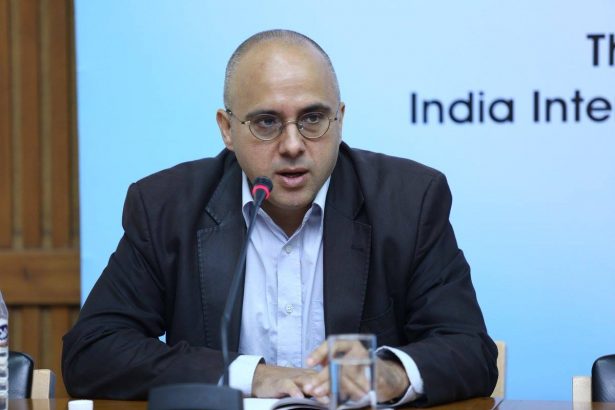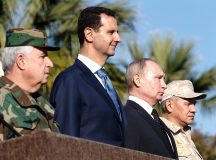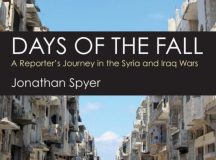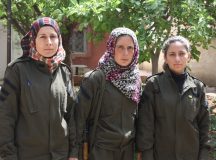The claim that the pro-Western alliance in the region has collapsed in the wake of a US withdrawal is an exaggeration, says Jonathan Spyer. Yes, the old map of relationships is in flux as the US draws down, but Israel, the UAE, Saudi Arabia, Bahrain and Egypt continue to share a long list of shared concerns about Iran and Jihadism, and any new map will reflect that. Indeed, in the medium to long term the US retreat is likely to provide an advantage to Israel as the only country within this group of states that is able to provide a credible military threat against Iran, and specifically against the Iranian nuclear programme.
Part 1: The Old Map
Mainstream Israeli foreign policy analysis in recent years has depicted the key strategic dynamic in the region as a contest between a number of rival camps. These camps varied greatly both in their quantitative size, their relative strength, and the extent to which they were strongly linked and possessed a clear, common sense of mission. Nevertheless, the notion of a competition between rival alliances was a useful analytic tool, able to account for both the motivations and the behaviour of states in a variety of regional contexts.
This author was among the analysts who employed this characterisation and found it useful. In my own estimation, and that of a number of others, it has been possible to discern four broad regional camps. These are:
(i) Iran’s regional alliance
The regional alliance consisting of the Islamic Republic of Iran and its various proxies, allied regimes and satellites. The latter include the Assad regime in Syria, the Popular Mobilization Units/Shia militias in Iraq, Lebanese Hezbollah, the Ansar Allah/Houthis movement in Yemen, Palestinian Islamic Jihad, the Hamas area of control in Gaza (partially) and a number of smaller Shia Islamist opposition movements in the Gulf. This camp is the most crystallised and well organised of regional alliances. The Iranian regime, via such agencies as the Islamic Revolutionary Guards Corps (IRGC), its expeditionary Qods Force, and the Ministry of Intelligence and Security (MOIS, commonly known to Iranians as the ‘Etelaat’) exercises a high level of influence and in some cases control over other elements of this alliance. The Iranian method of establishing and then utilising proxy political-military formations across the Arab world has proved especially useful to Tehran over the last decade in building power and influence across the poorly or partly governed spaces of the Arabic speaking world – Syria, Iraq, Yemen, Lebanon and to a degree among the Palestinians. It is noteworthy that this alliance consists almost exclusively of Shia formations. The Palestinians and arguably the Alawi dominated Assad regime are the exceptions to this general rule.
(ii) Sunni Political islam
A second discernible power alliance in the Middle East has been gathered around the broad banner of Muslim-Brotherhood (MB) type Sunni political Islam. This group includes AKP-ruled Turkey, the Emirate of Qatar, Hamas-controlled Gaza, the UN recognised Libyan government in Tripoli, the Turkish supported Syrian National Army in northern Syria and a number of smaller opposition groups.
(iii) Salafi Jihadi Political Islam
A third regional trend is that of Salafi jihadi political Islam. This finds organisational form in two region wide networks – al-Qaeda and the Islamic State. There is some crossover between this camp and the previously noted bloc of MB-style Sunni political Islam.
(iv) The Western-Aligned ‘Moderates’
In opposition to all these groups, Israeli analysts have discerned a much looser gathering of states broadly aligned with the West, and broadly opposed to political Islam in both its Shia and Sunni variants. Within this loosely defined bloc, there have throughout been strong differences in the relative importance attached by members to this or that challenge. There is also no real unifying mode of governance or broad outlook uniting the members of this camp. Rather, such commonality as exists derives from a perception of shared threats from one or all of the other groupings noted above, and a broad alignment with the US and the West. This group is often held to include Israel, the United Arab Emirates (UAE), Egypt, and Saudi Arabia as core elements. Other members include Jordan, Bahrain, Morocco, the Iraqi government of Prime Minister Mustafa al-Kadhimi. Non-state affiliates to this broad grouping include the Kurdish Regional Government of Prime Minister Masrour Barzani in northern Iraq (KRG), the Palestinian Authority (PA) of President Mahmoud Abbas, and the Autonomous Administration of North and East Syria (AANES).
The list of names to be included in this broadly defined grouping reveals immediately its loose and contingent nature. It includes countries with no formal diplomatic relations (Israel-Saudi Arabia), entities involved in unresolved conflict with one another (Israel-PA), and countries with a variety of systems of governance, ranging from absolute monarchy and theocracy (Jordan and Saudi Arabia) to representative democracy (Israel), via authoritarian semi-democracy (KRG, AANES).
It is clear that this depiction of camps in the Middle East involves a certain level of simplification, in that the dividing lines between these blocs have never been absolute. Israel and Turkey, for example, retain a healthy trade relationship despite diplomatic difficulties. Turkey’s relations with Iran are similarly ambiguous, combining strategic rivalry with cooperation against common adversaries in certain areas (see the role of Turkish banks in enabling Teheran to bypass sanctions.) There was never, also, a clear dividing line between the Turkey-Qatar camp and that of the Salafi jihadis. Rather, as exemplified in Syria, Libya and Azerbaijan, Turkish and Qatari efforts at making use of paramilitary proxies have involved de facto collaboration with Salafi forces.
Nevertheless, despite these inconsistencies, observation of events over the last decade in the region indicate that this broad framework contained a considerable amount of descriptive relevance, and some predictive power. An observer using this broad map of rival camps, for example, as a guide to understand the region would not have been surprised by the signing of the Abraham Accords between Israel and the UAE, Bahrain, Morocco and Sudan in August, 2020. Rather, this would be seen as the formalisation of already existing links and commonalities based on shared enemies and a broadly pro-Western outlook.
Similarly, Turkish and Qatari support for the MB associated government of National Accord in Tripoli, and Egyptian and Emirati backing for the Ancien Regime general Khalifa Haftar in the same country, would make clear sense within this framework (some evidence has also emerged of Israeli involvement in support for Haftar).
The Iranian investment in support for proxy militias in Syria, Lebanon, Iraq and Yemen, even at a time of economic difficulty for Iran, similarly makes sense when viewed through this framework of regional strategic rivalries.
Part 2: A New Map
US Drawdown
In the course of the last year, however, a number of developments have taken place which raise serious questions regarding whether it is still possible to maintain the existence of a broad alliance of pro-Western states in the region, arrayed in opposition to the other three alliances listed above.
Specifically, efforts at rapprochement between the UAE and Iran, the opening of talks between Saudi Arabia and Iran, similar moves between the UAE and Turkey, and between Egypt and Turkey, raise the question as to whether the broad framework for viewing the region outlined above now needs to be replaced with a new map. Similarly, UAE rapprochement with Assad’s Syria, and its pioneering of efforts to return the Assad regime to the Arab fold (the UAE reopened its embassy in Damascus in 2018) appear to go against the ongoing Israeli campaign against Iranian efforts at consolidation and entrenchment in Syria, in alliance with Assad. The Israeli interest, after all, is in the continued weakness and isolation of the Assad regime, which makes possible the prosecution of the Israeli bombing campaign on Syrian soil.
These moves, in turn, derive from a sense of flux in the region caused by the perception that the US is leaving, or at least greatly lessening its focus on the Middle East. This makes problematic the notion of a bloc of US-aligned states preserving regional order and perceived by both friends and foes as enjoying the clear backing of Washington DC.
This perception of US withdrawal or partial drawdown is not new. It has been apparent for a decade that Washington wishes to avoid further major commitments, is centrally committed to facing the peer-level strategic challenge of China in the Indo-Pacific, and no longer has a pressing need based on its own energy requirements to underwrite the security of the region.
A series of events have taken place in the region to reinforce this sense of US drawdown. Among them: The Obama Administration’s failure to enforce stated red lines with regard to the Assad regime’s use of chemical weapons in Syria in August 2013; the same Administration’s decision to quit Iraq in 2011 (before returning to face ISIS in 2014); the Trump Administration’s erratic announcement of a withdrawal from Syria, on two occasions, in 2018 and 2019, before failing to complete the withdrawal and, very importantly, the failure to defend Saudi Arabia after the large scale attack on the Abqaiq and Khurais oil-processing facilities on 14 September 2019. The Biden Administration’s rapid withdrawal from Afghanistan in August 2021 has also served to raise concerns among US allies about the reliability of Washington’s commitments, and hence the advisability of depending on them.
Gulf States Recalibrate
This has led to efforts by Gulf countries at shifting away from a rigid notion of regional cold war. Hence the Emirati outreach to Iran after the Fujayrah incident on 12 May 2019, in which an Emirati registered vessel, two Saudi registered oil tankers and a Norwegian registered oil tanker were attacked, almost certainly by Iran, off Emirati waters.
Emirati outreach to Iran is now accompanied also by Saudi-Iran talks, and by Emirati, Saudi and Egyptian efforts at normalising relations with the Assad regime in Syria, contrary to the US stance in favour of continued isolation for Damascus.
Since Syria is a strategic ally of Iran, these efforts form an additional element in attempts by the UAE, supported by Saudi Arabia, Egypt and Jordan, to move beyond previously existing patterns.
Some pro-Emirati voices have suggested that these moves represent the birth of a new strategic period in the region, in which competition between rival blocs will be replaced by economic cooperation between regional countries.
It’s too soon to call time on the anti-Iran alliance
This situation led to some voices in Israel in 2021 warning that Jerusalem is in danger of being left behind by events – remaining isolated in a position of concern vis a vis Iranian regional ambitions, at a time when other ostensible members of the pro-US bloc in the region are, in the wake of US negotiations with Iran for a return to the JCPOA, normalising relations with Iran and its allies.
According to this view, as exemplified by senior Haaretz correspondent Zvi Barel in an October 14 article, entitled ‘Teheran-Riyadh détente could mark the end for Israel’s anti Iran coalition,’ ‘if the negotiations between the House of Saud and the Islamic Republic of Iran do result in an agreement and normalization, this will be the final chapter of the anti-Iranian coalition’. He adds: ‘Israel relied heavily on this coalition.’
But subsequent events do not appear to be developing along the lines of increased normalisation for Iran vis a vis its Arab neighbors and the US, and consequent Israeli isolation.
Rather, the nuclear negotiations between the US and Iran are at deadlock. Meanwhile, Saudi-Iranian negotiations are continuing but with little apparent progress. In a recent France24 interview with Saudi Foreign Minister Prince Faisal bin Farhan al Saud, the latter noted that so far talks have been ‘exploratory,’ rather than substantial. The foreign minister pointed to sharp differences on the issue of Iranian nuclear efforts, and domination by Hezbollah of Lebanon. These are matters of deep division, in which the basic ambitions of the sides seem diametrically opposed. Short of the abandonment by one or other of the sides of core positions on these matters, and on additional areas of dispute such as Yemen and Iraq, it is difficult to see how these differences will be bridged.
The regional competition between the sides, meanwhile, appears far from over. In the last week of October, Saudi Arabia, the UAE and Bahrain withdrew their ambassadors from Lebanon. The precipitating issue was remarks made by Lebanese Information Minister George Kordahi criticising the Saudi role in Yemen. But clearly, beyond this is the Saudi view that Lebanon is now an asset owned by Iran. The removal of ambassadors follows the imposition of sanctions on Lebanon by Saudi Arabia in April.
Similarly, intense concerns at the advances made by the Iranian nuclear programme remain common to Israel and the Gulf monarchies. The current situation, in which Teheran is enriching uranium to the 60 per cent level, stockpiling enriched uranium at quantities far beyond that permitted by the JCPOA and producing uranium metal, along with its continued efforts at regional hegemony and its investments in its ballistic missile programme are of deep concern to Gulf countries. They remain also concerned regarding the issue of Sunni political Islam. These issues have not disappeared because of the current regional flux brought about by the US relative drawdown. Rapprochement with or surrender to Iran cannot address these problems. Connections to Israel, formal or informal, are an important element in doing so.
On the issue of Syria, meanwhile, UAE led diplomatic efforts toward ending the isolation of the Assad regime are continuing apace. But it is highly unlikely that this will result in a substantial distancing of the Syrian regime from Iran. Iran is entrenched within the Syrian state forces, and controls one of Syria’s international borders (Albukamal/Al-Qaim). Iran offers the regime a type of ground level, hard power support which the Gulf states cannot replicate. It is therefore likely that the Assad regime will seek to benefit from connections to both camps, while avoiding a decision to fully commit to either.
Thus, the notion of a collapse of a pro-Western alliance in the region in the wake of a US withdrawal is an exaggeration. But it derives to a degree from an earlier exaggeration in the opposite direction. The pro-Western alliance in the region was always a complex and somewhat fragile arrangement. Israel and the UAE, for example, while seeing a list of threats in common, have always prioritised different items on this list. For Israel, the Iranian threat is deemed paramount, the challenge of the Iranian nuclear programme front and center, and all other issues secondary. For the UAE, by contrast, the challenge of MB-style Sunni political Islam, and indeed the regional ambitions of Turkey itself and its alliance with Qatar, constituted threats of no less urgency to the Iranian challenge. The UAE also engages in a burgeoning trade relationship with Iran (it is Iran’s second largest trading partner, after China).
But these differences of emphasis do not detract from the long list of areas of commonality and shared concern between Israel, the UAE, Saudi Arabia, Bahrain and Egypt, as the core members of this alliance: in essence, this remains an alliance of status quo states, broadly aligned with the West, and hostile to political Islam, in both its Shia (Iran led bloc) and Sunni (Turkey led bloc, Salafis) forms.
It should be noted that while there is undoubtedly a sense of flux in the strategic picture of the region at present, deriving from the US change of focus, in the medium to long term this is likely to provide an additional advantage for Israel. Israel is the only country within this group of states that is able to provide a credible military threat against Iran, and specifically against the Iranian nuclear programme. It is becoming increasingly apparent to regional powers that the US, despite occasional statements by senior officials, has no intention of laying down a serious military threat to the Iranians, in the event that the current push towards a nuclear weapons capacity continues. In the absence of this threat, there is a risk that Teheran may see no disincentive toward pushing on to a threshold nuclear weapons capacity, while continuing in its efforts to seed proxies and exploit them for both political and military purposes throughout the region.
Only Israel can provide such a ‘plan B’. This is not, of course, to underestimate the very serious apparent limitations to Israeli options in this regard. A single operation to destroy the Iranian nuclear programme, of the type mounted against Iraq in 1981 and Syria in 2007 is probably not possible vis a vis the Iranian programme, because of its spread out and well defended nature. But Israel, in its current campaign against Iranian efforts in Syria, Lebanon and sometimes also Iraq, is demonstrating currently the only real hard power pushback to Iranian attempts at regional domination. The UAE, Saudi Arabia and other countries threatened by the prospect of Iranian hegemony, are likely to find an obvious utility in the maintenance of this pushback, particularly in a situation where an alternative hard power deterrent element is not available.
In this regard, it should be noted that while it is often stated that Iran has, through its use of proxies, succeeded in partially ‘surrounding’ Israel – through its control or partial control of proxies in Gaza, Lebanon, Syria and Iraq – it is also the case that Israel appears to be following a diplomatic strategy which seeks similarly to surround Iran. This is attempted not, as in the Iranian case, by organising proxies, but rather by seeking alliance and closer relations with countries in close proximity to Iran. Such countries include Saudi Arabia, the UAE, Bahrain, and, notably, Azerbaijan, to Iran’s north.
The strategic contest between Iran and its allies, and the loose, interests-based alliance of West-aligned countries is thus set to continue in the Middle East. The contest is based on concrete issues, and on the impossibility for West-aligned countries of accommodating Iranian ambitions, because of the extent and scope of those ambitions – both in the nuclear field, in Iran’s efforts to subvert and dominate Arab states, and in its ambitions to destroy Israel. It is important to understand the deep rationale behind this process, and not to be caught up by momentary developments into concluding either that the anti-Iran alliance is about to break up, or, conversely, that it has greater depth, solidity and potential than it in fact possesses.




































